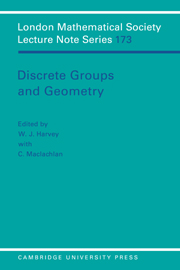Book contents
- Frontmatter
- Contents
- Preface
- Symmetries of modular surfaces
- Lifting group actions to covering spaces
- A combinatorial approach to the symmetries of M and M–l Riemann surfaces
- Inequalities for Pell equations and Fuchsian groups
- The Euler characteristic of graph products and of Coxeter groups
- Infinite families of automorphism groups of Riemann surfaces
- Planar hyperelliptic Klein surfaces and fundamental regions of NEC groups
- An example of an infinite group
- Moduli of Riemann surfaces with symmetry
- Modular groups – geometry and physics
- On automorphisms of free products
- The growth series of the Gieseking group
- Exceptional representations of PSL2(q) of monodromy genus zero
- On the rank of NEC groups
- The geometry of bending quasi-Fuchsian groups
- Farey series and sums of continued fractions
- Commensurability classes of two-generator Fuchsian groups
- Limit points via Schottky pairings
- Diagonalizing Eisenstein series III
- Some remarks on 2-generator hyperbolic 3-manifolds
- Uniformization, graded Riemann surfaces and supersymmetry
- Generating sets for finite groups
- Group actions on trees with and without fixed points
Infinite families of automorphism groups of Riemann surfaces
Published online by Cambridge University Press: 10 December 2009
- Frontmatter
- Contents
- Preface
- Symmetries of modular surfaces
- Lifting group actions to covering spaces
- A combinatorial approach to the symmetries of M and M–l Riemann surfaces
- Inequalities for Pell equations and Fuchsian groups
- The Euler characteristic of graph products and of Coxeter groups
- Infinite families of automorphism groups of Riemann surfaces
- Planar hyperelliptic Klein surfaces and fundamental regions of NEC groups
- An example of an infinite group
- Moduli of Riemann surfaces with symmetry
- Modular groups – geometry and physics
- On automorphisms of free products
- The growth series of the Gieseking group
- Exceptional representations of PSL2(q) of monodromy genus zero
- On the rank of NEC groups
- The geometry of bending quasi-Fuchsian groups
- Farey series and sums of continued fractions
- Commensurability classes of two-generator Fuchsian groups
- Limit points via Schottky pairings
- Diagonalizing Eisenstein series III
- Some remarks on 2-generator hyperbolic 3-manifolds
- Uniformization, graded Riemann surfaces and supersymmetry
- Generating sets for finite groups
- Group actions on trees with and without fixed points
Summary
Introduction
Let a, b be two rational numbers, with a > 0. Consider the sequence Na,b : g ↦ ag + b, for g = 2,3,…. We say that this sequence is admissible if for infinitely many values of g the number ag + b is the order of an automorphism group G of a compact Riemann surface Xg of genus g. When this occurs, the pair (Xg,G), or simply Xg or G, is said to belong to Na,b.
A cocompact Fuchsian group gives rise to an admissible sequence of the form a(g – 1), where a is a positive rational number which depends only on the group. For example the {2,3, 7}–triangle group gives rise to the sequence 84(g – 1); see Macbeath [Me] for an early thorough discussion of these aspects. Conversely, it was shown in [K] that every admissible sequence of the form a(g – 1) arises from a fixed finite number of cocompact Fuchsian groups.
There are a few known admissible sequences Na,b where a + b ≠ 0. Wiman showed that 4g + 2 is the largest order of a cyclic automorphism group of a compact Riemann surface of genus g, and he also exhibited such surfaces for every g; see [W], [H] Accola and independently Maclachlan showed that for infinitely many values of g the largest order of an automorphism group of a compact Riemann surface of genus g is 8g + 8.
- Type
- Chapter
- Information
- Discrete Groups and Geometry , pp. 47 - 56Publisher: Cambridge University PressPrint publication year: 1992
- 3
- Cited by

